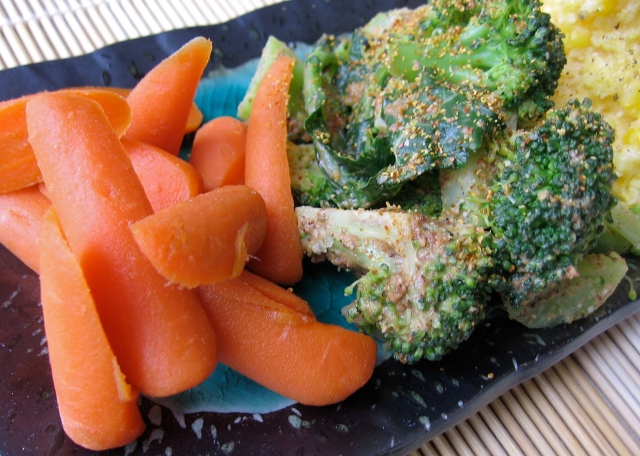“Five tastes, or go mi, describes what the Japanese call anbai, the harmonious balance of flavors – salty, sour, sweet, bitter, and spicy – that ensures that our palates are pleasantly stimulated, but not overwhelmed.” — Elizabeth Andoh, Washoku: Recipes from the Japanese Home Kitchen
I haven’t posted a washoku meal for a while now. I began my exploration of the Japanese “harmony of food” by attending to the five colors (red, yellow, green, black, and white) on my plate. Then I turned my attention to the principle of “five ways,” which encourages the cook to incorporate several different cooking methods in preparing the meal.
Today’s lunch focused on inclusion of the five flavors. I had sweet from the corn in the polenta and the mirin-sake-tamari-shitake broth in which the carrots had been simmered. Salty came from the miso in the goma miso dressing and spicy from the red pepper-yuzu condiment sprinkled on the broccoli. I made a little salad of radish, hijiki, black sesame seeds, and rice vinegar which pulled in bitter and sour notes to complement the rest of the meal.
Five colors were also represented – red from the carrot and radish, yellow from the polenta, green from the broccoli, black from the hijiki and sesame seeds, and white from the radish – as were five cooking methods – simmered carrots, steamed broccoli, dry-roasted sesame seeds in the goma miso sauce, and the radish salad which was somewhere between pickled and raw.
I had wondered if the polenta, which is fairly neutral but still tagged as “Mediterranean” in my mind, would go well with the Japanese flavors of the carrots and broccoli. As promised by washoku, however, somehow the radish salad, with its crisp texture and bright flavors, created a kind of flavor bridge that pulled the whole meal together, and indeed I found my palate “pleasantly stimulated, but not overwhelmed.”
Goma Miso Dressing
This is one of my favorite sauces. I can rarely resist ordering goma ae (goma miso sauce over cooked spinach) at Japanese restaurants. I hadn’t realized how easy it is to make at home!
Recipe is from Elizabeth Andoh’s Washoku: Recipes from the Japanese Home Kitchen .
1/4 cup white sesame seeds
2 T. sweet, light miso
Scant 1/4 cup dashi (I used my mirin-sake-tamari broth instead)
pinch of salt, if needed
Heat a small, heavy skillet (dry, without oil) over medium-high heat and add sesame seeds. Stir with a wooden spatula or gently swirl pan occasionally. In about a minute the seeds will begin to darken and you’ll smell them – remove from heat and continue to stir seeds in pan for another 20-30 seconds. If the seeds look in danger of scorching, put them immediately into the food processor. (The seeds may pop quite a bit – I like to cover my pan with a splatter screen while roasting the seeds.)
Process still-warm seeds in a food processor until all the seeds have been evenly crushed. Add a tablespoon of the miso and two tablespoons of the broth and pulse until combined. Taste and adjust sweetness with salt, if needed. Scrape down the sides of the food processor bowl, add the remaining miso and broth, and pulse until smooth. Makes about 1/2 cup, which was way more than enough for three large stalks of broccoli.







